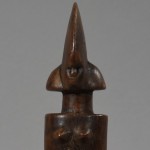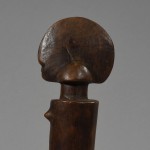LUK 1004-4
Zaramo Mwana Hiti Figure, Tanzania
This is an unusual fine, old Mwana hiti fertility doll from the Wajaramo tribe in Tanzania. Unusually well carved in a dark brown, shiny surfaced patina. The ‘doll’ itself is special. Note the abstract, cylindrical female body shape with the two small bulging breasts. The lofty crested hair style and the cute little face but also the fact that she is placed on a ‘pedestal’ in the shape of a tree-legged stool makes her more special.
It is obvious that the quality of this fertility figure shows that it is wealthy parents to the girl that has given this doll as a present after her initiation. As a tradition, the girl will treat the doll with motherly care. She will wash the dolls, carry them around, put them to bed, dress, and even “feed” them hoping to conceive her own child when she is sexually mature and marriageable and hope that her that her future child would be born healthy.
The father of the young initiate mwali gives order for carving a mwana hiti figure, afterwards it is given to the clan leader who places it near ancestor figures in order to make their power passing over into the doll. After a further special treatment the girl receives the doll.
The term mwana hiti loosely means ‘child made of wood,’ and refers to iconic figures that depict a highly stylized female torso. The figures are commonly referred to as ‘dolls’ but they are anything but dolls as they play significant roles in the spiritual lives of a wide range of ethnic groups in Tanzania. They are almost exclusively used by female initiates during seclusion and coming out ceremonies. Smaller ones are often worn as amulets by women wishing to enhance their fertility. The figures are also found on thrones, stools and staffs of the region and often times represent ancestors and are depicted in pairs. (Quote of Felix, March in “Mwana Hiti : Life and Art of the Matrilineal Bantu of Tanzania / Leben und Kunst der Matrilinearen Bantu von Tansania”.
Age: Est. beg.- mid. 20th Century
Condition: Despite age and constant use, there are no cracks or other damage to see.
Dimensions: H: 28, W:6, D: 8 cm
Publication: 1914. Dank, Kaiser Wilhelm. Deutschland als Kolonialmacht: Dreissig Jahre deutsche Kolonialgeschichte.
Comments:
Jim Ross, (10/2/2004): A very similar figure appears in Kurt Krieger’s 1990 book Ostafrikanische Plastik” (fig. 280), captioned: “Zaramo Tanzania III E 3505 Stuhlmann 1894 Hohe 12,6 cm” (p43).
Aforementioned Berlin doll [RAAI Editor:but probably a different Berlin doll based on 7/3/13 comment] appears in Collecting African Art by Werner Gillon (1979) fig 194 with the following caption:”Mwana Kiti fertility doll. Collected in 1894. Zaramo, coastal area of Tanzania; wood, 14 cm (5-1/2″). Museum für Völkerkunde, Berlin.”
Jim Ross, (8/24/2010): Another similar object is in the collection of the Minneapolis Institute of Arts (Accession Number 98.24.2) and is labeled on the museum’s website as “Mwana nya nghiti.”
Jim Ross, (7/2/2013): A color photograph of what seems to be the Berlin Museum doll referred to in the 2nd paragraph of the 10/2/04 comment with a profusion of glass beads around its neck appears in fig 4.2 on p.137 in Shangaa. Art of Tanzania edited by Gary van Wyk, 2013, 1-341, QCC Art Gallery, The City University of New York with the following caption: “Doll. Zaramo, 19th century. Wood, glass beads, thread. Height: 14 cm (5-1/2 inches). Collection of the Ethnologisches Museum Staatliche Museen zu Berlin, Acc. No. III E 3508.”
Request price for Zaramo Figure




